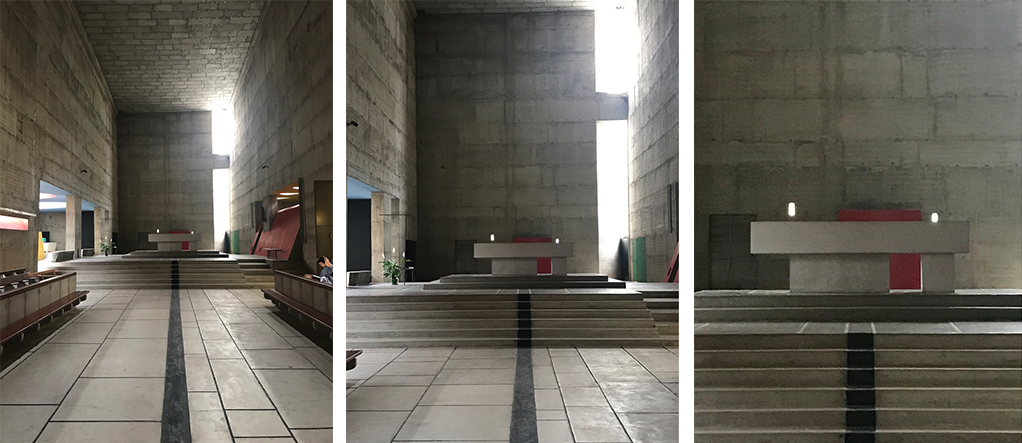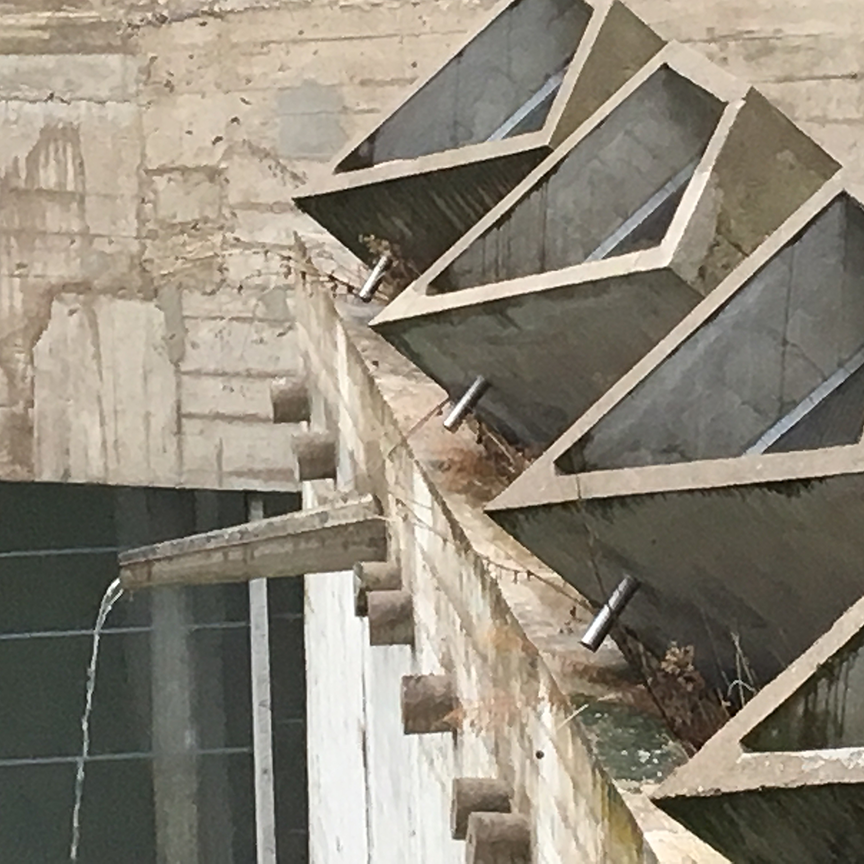
La Tourette by Le Corbusier. If you travel to Lyon for either the cultural sites or for a once-in-a-lifetime culinary experience (in 2010, UNESCO added France’s gastronomy tradition to the “world intangible heritage”) you may wish to stay a half-day longer to visit an icon of modern architecture.
Situated 25 miles in the hillside west of Lyon and easily accessible by train or car, the Dominican monastery of La Tourette (1956-61) overlooks the town of Eveux-sur-l’Arbresle, and is the creation of famed Swiss architect Charles-Edouard Jeanneret, commonly known as Le Corbusier (1887-1965). Completed in 1961 and recognized in 2016 as part of UNESCO “World Heritage Sites,” the Architecture –yes, with a capital A, remains one of the most recognizable works of Le Corbusier’s oeuvre, and continues to welcome neophyte visitors, students, and faculty in architecture from all over the world.
Image 1: Light at La Tourette (author’s collection)
Location
Sainte Marie de La Tourette stands majestically on a sloped site and represent in its purity Le Corbusier’s five points to create modern architecture:
- the pilotis (load bearing columns)
- the roof garden
- the free plan
- the free façade, and
- the ribbon window
The architecture exhibits reinforced concrete as the main structural load bearing system, with stucco, wood and glass for finishes, glazing and cabinetwork, resulting in a place of pure poetry. What is so remarkable is that it blends tradition and innovation in a single structure. It is said that Le Corbusier got his inspiration from several sources, but this monastery finds it roots in the 12th century Cistercian abbey of Le Thoronet, located in southeast France.
Innovation
Innovations in architecture often results in radical and original form making, or they may occur in a more subtle and majestic way by simply adjusting the form and program of existing building types (i.e. libraries, theaters, hospitals, convents). A true master does both: this applies to La Tourette.

Image 2: Google Images – Cistercian Abbey of Le Thoronet (1176-1200); Dominican Convent of La Tourette by Le Corbusier (1961)
While all major attributes that form a monastery are clearly defined in the project –repetitive cells, cloister, sanctuary, and inner courtyard – the typical contemplative walk (physical and spiritual exercise), shifted from the model of a rectangular ambulatory to a one in the form of a cross (a move that took almost seven centuries!). This might seem benign, but this change may suggest metaphorically and physically the expression of Christ’s path towards crucifixion at Calvary. This is articulated in many ways as the visitor walks through the monastery, but most clearly experienced through the two intersecting ramp systems that are steeper than usual, thus making it difficult to walk on.
 Image 3: Interior of the church’s nave (author’s collection)
Image 3: Interior of the church’s nave (author’s collection)
Symbolism
There are so many wonderful moves throughout the building that reinforce the symbolism of Christ’s journey. For example, allowing the sanctuary, and its two side chapels, to be the only masses allowed to touch ground, a deliberate metaphor suggesting Christ’s descent to earth and return to heaven.
Image 4: entrance to the nave (author’s collection
Other examples are:
-
- the entrance door which, when opened to the sanctuary, forms a cross with the red light well across the aisle
- the chapels on either side of the sanctuary have seven and three “canons de Lumiere” (cones of light) which have biblical symbolism
- the suggestion of a Dominican Rosary expressed on the chapel’s exterior walls
The expressions of these spatial conditions are there for the visitor to discover and experience, and reflect faithfully and innovatively the architect’s desire to create a place for the silent and contemplative lifestyle of the friars.
 Image 5: Gargoyles above the south chapel (author’s collection)
Image 5: Gargoyles above the south chapel (author’s collection)
Spiritual retreat
If you are eager to find a place for a shorter or longer spiritual retreat, La Tourette offers simple accommodations in one of the 100 cells surrounding the cloister. Based on the modular, an anthropomorphic proportional system developed in 1943 on Le Corbusier’s ideal man, each cell encompasses three zones off the main public interior corridors
-
- an entrance with a sink and wardrobe (world of cleansing),
- a bed for sleeping (nightly rejuvenation)
- a desk for working (intellectual dimension)
Each cell extends to a small private balcony overlooking the majestic countryside. Bathroom facilities with private shower areas are provide on each floor. Three meals are provided in your lodging fee and take place in the main refectory that is shared with the remaining monks and other overnight visitors. I am reminded that it is exceptional to be able to visit and live architecture in such an authentic and meditative manner.
Additional blogs related to Le Corbusier
Le Corbusier, Sanskar Museum in Ahmedabad
Le Corbusier, Immeuble Clarte
Le Corbusier, Heidi Weber
Le Corbusier and the horizon
La Petite Maison by Le Corbusier
La Tourette by Le Corbusier

